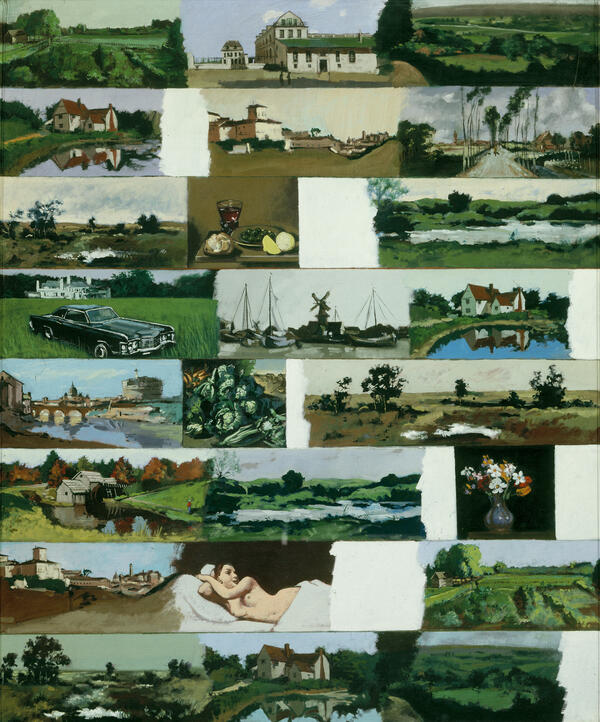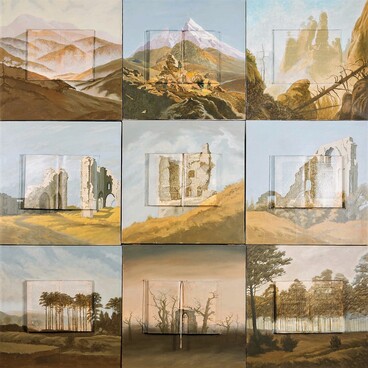The Ludwig Museum at the Russian Museum houses a painting “Statistical Landscape” by the American artist George Deem. The work contains reproductions of 24 pictures. The original paintings were created in the period between the 17th and the 19th century. Some of the works are easily recognizable. For example, the right painting in the second row from the top is 1689 “The Avenue at Middelharnis” by the Dutch artist Meindert Hobbema. Art experts consider him to be one of the most influential landscape painters, along with his teacher Jacob van Ruisdael.
While working on “Statistical Landscape”, Deem aimed to replace the traditional complicated iconography of original paintings with a reduced and simplified secret language of symbols. His knowledge of the technique of classical European painters helped him to achieve his goal. During his studies, Deem mastered the nuances of their technique and learned to paint high-quality copies.
Creating copies of works by great masters or fellow colleagues has always been a popular practice in the history of art. Before modern art reproduction technologies were invented, such copies helped to demonstrate popular paintings to more people. The vulnerability of art, the manipulations made possible by new printing technologies, and the corresponding changes became an important theme in the art of George Deem.
“Statistical Landscape” is neither a deconstruction of the original paintings nor an homage to these works. In his painting, Deem elaborates on the popular issue of the relationship between artworks and reproductions, while also analyzing whether a reproduction, standing in between the viewer and the original artwork, changes the perception of art.
Deem was born in Vincennes, Indiana in 1932. Growing up, he often worked on his father’s farm, and in 1952, he left to study at the School of the Art Institute of Chicago. A year later he was drafted into the army. After serving in Germany, he returned to the United States and completed his degree. He also attended classes at Illinois State University.
In 1963, Deem started to exhibit his works at the Allan Stone Gallery in New York City. For several years, he lived and worked in Cortona, Italy, researching the works and techniques of Renaissance painters. He also admired 17th-century Dutch artists and later even wrote a book about Johannes Vermeer.
In the late 1970s, Deem was a resident fellow and the Executive Committee secretary at the MacDowell Art Colony. The organization provided a safe haven for artists, architects, writers, film directors, and composers to study and work.
While working on “Statistical Landscape”, Deem aimed to replace the traditional complicated iconography of original paintings with a reduced and simplified secret language of symbols. His knowledge of the technique of classical European painters helped him to achieve his goal. During his studies, Deem mastered the nuances of their technique and learned to paint high-quality copies.
Creating copies of works by great masters or fellow colleagues has always been a popular practice in the history of art. Before modern art reproduction technologies were invented, such copies helped to demonstrate popular paintings to more people. The vulnerability of art, the manipulations made possible by new printing technologies, and the corresponding changes became an important theme in the art of George Deem.
“Statistical Landscape” is neither a deconstruction of the original paintings nor an homage to these works. In his painting, Deem elaborates on the popular issue of the relationship between artworks and reproductions, while also analyzing whether a reproduction, standing in between the viewer and the original artwork, changes the perception of art.
Deem was born in Vincennes, Indiana in 1932. Growing up, he often worked on his father’s farm, and in 1952, he left to study at the School of the Art Institute of Chicago. A year later he was drafted into the army. After serving in Germany, he returned to the United States and completed his degree. He also attended classes at Illinois State University.
In 1963, Deem started to exhibit his works at the Allan Stone Gallery in New York City. For several years, he lived and worked in Cortona, Italy, researching the works and techniques of Renaissance painters. He also admired 17th-century Dutch artists and later even wrote a book about Johannes Vermeer.
In the late 1970s, Deem was a resident fellow and the Executive Committee secretary at the MacDowell Art Colony. The organization provided a safe haven for artists, architects, writers, film directors, and composers to study and work.



